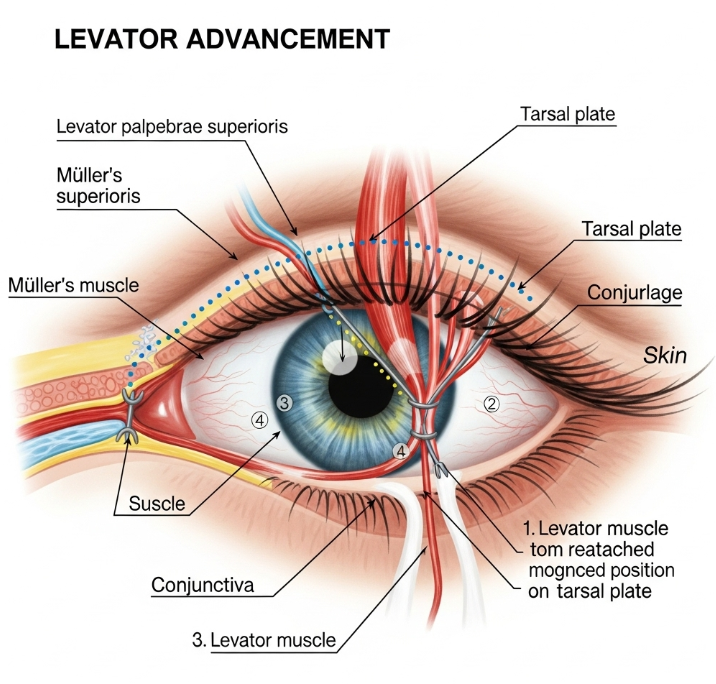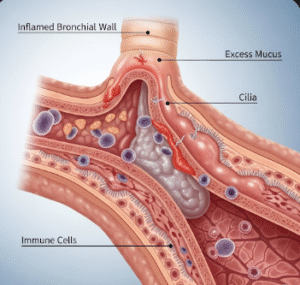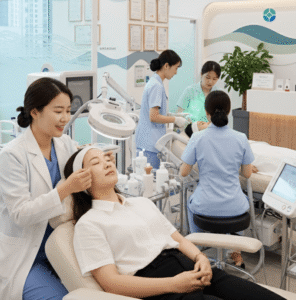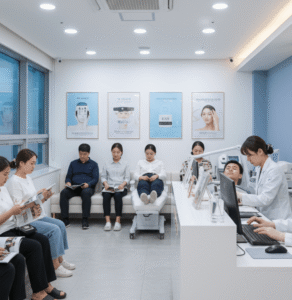What It Is
Levator advancement is a surgical procedure used to correct ptosis (drooping of the upper eyelid) by tightening or repositioning the levator muscle, which is responsible for lifting the eyelid. When the levator is weak or stretched, the eyelid droops and may block vision or make the eyes look tired.
In Korea, levator advancement is performed by oculoplastic and plastic surgeons with expertise in both functional and cosmetic eyelid surgery. The goal is to restore a natural-looking lid position while improving vision and symmetry.
Why It’s Done
Levator advancement is recommended when:
- The upper eyelid droops and affects vision
- Patients have a tired or sleepy appearance due to eyelid sagging
- Eyelid asymmetry is noticeable and impacts facial harmony
- Non-surgical methods (like special glasses) are not effective
It improves both function (vision) and cosmetic appearance of the eyelids.
Alternatives
- Frontalis sling surgery: Used for severe ptosis when the levator muscle is very weak
- Müller’s muscle-conjunctival resection (MMCR): A less invasive option for mild ptosis
- Non-surgical options: Special glasses with eyelid crutches (temporary and rarely used long-term)
The choice depends on the degree of eyelid droop and levator muscle strength.
Preparation
Preparation for levator advancement in Korea usually includes:
- Consultation: Eyelid measurements and strength testing of the levator muscle
- Ophthalmic exam: To check for visual obstruction and eye health
- Medical evaluation: Basic tests and anesthesia clearance
- Lifestyle changes: Avoiding smoking and alcohol for at least 2 weeks before surgery
- Medication review: Temporarily discontinuing blood thinners and certain supplements
How It’s Done
The procedure is typically done under local anesthesia with sedation or general anesthesia for children or anxious patients. It usually takes 1–2 hours.
- A small incision is made in the natural eyelid crease
- The levator muscle is identified and tightened or reattached to the tarsal plate
- Eyelid height and contour are adjusted for symmetry
- The incision is closed with fine sutures that leave a hidden scar in the eyelid crease
Recovery
- First week: Swelling and bruising are common; cold compresses help reduce discomfort
- Stitch removal: Usually within 5–7 days
- Daily activities: Most patients return to light activities within a week
- Healing: Swelling improves in 2–3 weeks, with final results in 2–3 months
- Vision: Many patients notice immediate improvement in their field of vision once the eyelid is lifted
Possible Complications
While levator advancement is highly effective, risks include:
- Overcorrection or undercorrection of eyelid height
- Asymmetry between eyelids
- Infection or bleeding
- Scarring (usually minimal and hidden in the crease)
- Temporary dry eyes or difficulty closing the eyelid completely
- Rare need for revision surgery
Treatment Options in Korea
Diagnosis
- Precise eyelid measurement and levator function testing
- Visual field testing if drooping affects sight
Medical Treatments
- Eye ointments and lubricating drops to protect the eyes during recovery
- Antibiotics and pain relief if needed
Surgical or Advanced Therapies
- Levator advancement: Standard technique for mild to moderate ptosis
- Levator resection: For more severe cases with partial levator function
- Frontalis sling surgery: For very weak levator muscles
- Combination procedures: Eyelid surgery with double eyelid creation for cosmetic goals
Rehabilitation and Support
- Scar management with ointments or laser therapy if needed
- Follow-up visits to check eyelid position and healing
- International patient services with translation, care coordination, and virtual follow-ups













